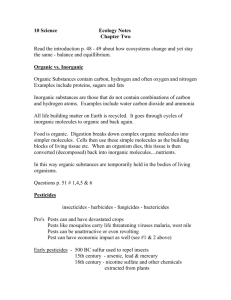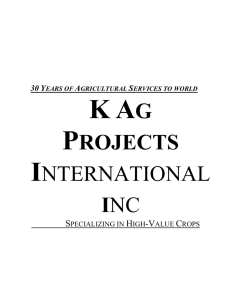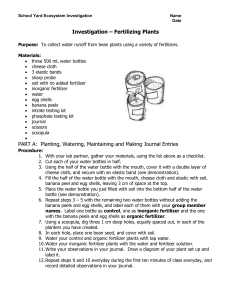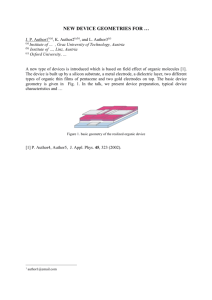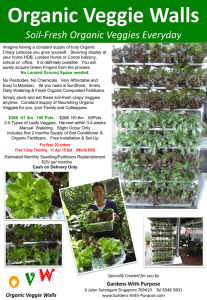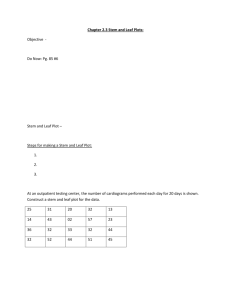The Effect of Organic and Inorganic Fertilizers on the Growth and
advertisement
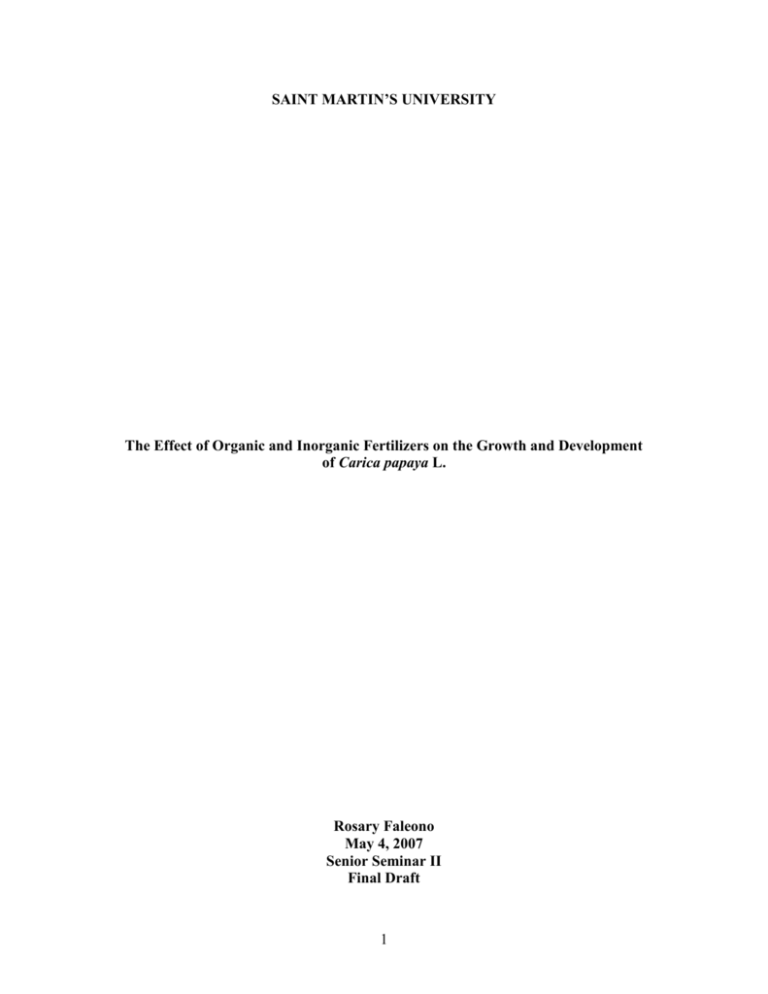
SAINT MARTIN’S UNIVERSITY The Effect of Organic and Inorganic Fertilizers on the Growth and Development of Carica papaya L. Rosary Faleono May 4, 2007 Senior Seminar II Final Draft 1 Table of Contents Abstract…………………………………………………………………………..pg. 2 Introduction………………………………………………………………………pg. 2 - 6 Materials and Methods…………………………………………………………...pg. 6 - 8 Seed Management………………………………………………………...pg. 6 - 7 Application of Organic and Inorganic Fertilizer………………………….pg. 8 Measurements and Data Analysis……………………………………… pg. 9 Results….…………………………………………………………………………pg. 9 - 14 Discussion…………………………………………………………………………pg. 14 -16 Acknowledgments……………………………………….………………………..pg. 16 - 17 Literature Cited………………………………………….………………………..pg. 18 2 ABSTRACT The frequent use of fertilizers is important for the production of agriculture around the world today. Carica papaya L. is a tropical fruit plant, a widely consumed agricultural product for its production of papaya fruit. I hypothesized that organic fertilizer applied on a weekly basis would generate a faster growth rate in Brazilian Sunshine papaya plants compared to inorganic fertilizer. I used Miracle-Gro® Water Soluble All Purpose Plant Food as the inorganic fertilizer and Alaska Fish Emulsion as the organic fertilizer. The control group was treated with tap water. The growth rates were measured after germination for a total of four weeks. When all data had been collected, I used Analysis of Variance tests to compare the growth rates and development of leaf width, leaf length, and stem height among the inorganic, organic, and water treatments. My results did not show significant differences among the growth and development of papaya plants treated with water, organic fertilizer, or inorganic fertilizer. Also, there were no differences in the growth and development of the papaya plants between the use of either fertilizer or water. All the papaya plants steadily increased in size. INTRODUCTION Carica papaya L., commonly known as papaya in the United States is a large, woody, fruit-bearing plant believed to have originated either from Central America or southern Mexico. Papayas are only found in places where the weather is warm, approximately 22°C to 26°C, and are located in every tropical and subtropical region around the world. Papayas are famous for their fruit, also called papaya, that are pear-shaped and taste somewhat like cantaloupe. There are many types of papaya. Homestead Selection papaya, Solo Line 8 papaya, and Brazilian Sunshine papaya are just a few members of the papaya family (Dedolph, 1962; Aiyelaagbe et al., 3 1985). There was no particular reason why I decided to use Brazilian Sunshine papaya other than the fact that it germinates in a matter of a few weeks under proper care. The frequent use of fertilizers is an important part of agricultural production around the world (Chand et al., 2006). For several years, major crop producers have preferred the use of inorganic fertilizers due to its high yield in crop productivity. However, long-term applications of inorganic fertilizers have caused a noticeable decrease in crop productivity and an increase in pollution around its surrounding environment (Chand et al., 2006). Recently, many agricultural companies have shifted from using inorganic fertilizers to organic fertilizers (Luo et al., 2006). A study was conducted to determine the yield responses and leaf nutrient concentrations broiler chicken manure had on lima bean production (Luo et al., 2006). Two fertilizers were tested: organic broiler manure (BM) and inorganic ammonium nitrate (AN). During the first year, both fertilizers were applied all at once with no further applications of fertilizers for that year. On the second year, BM treatments were applied only once and AN treatments were split into three separate, but equal applications. Along with the fertilizers, water was also applied to the lima beans by the use of an overhead sprinkler. After the 2-year period, the crops were harvested and lima bean yield was determined. Results from the study showed variance in leaf nutrient concentrations, but fresh pod yields were an equal amount or higher with BM treatment than AN treatment (Luo et al., 2006). These results were similar to those from previous studies with the same fertilizers on sweet corn, cabbage, and forages, which are crops grown to feed livestock. Due to the low yield production of agriculture with the use of organic manures, the application of organic fertilizers with little or no fossil fuel-based inorganic fertilizers is rapidly gaining favor (Anwar et al., 2005). In 2005, Anwar et al. studied the effect of a combination of 4 organic manures and inorganic fertilizers on the growth and quality of essential oil of European and Reunion basil crops. There were six treatments (T) used to grow the basil crops. T1 was the control consisting of only water; T2 was the farm yard manure (FYM); T3 was the vermicompost, an organic fertilizer consisting of a mixture of partially decomposed organic waste, bedding, and worm castings; T4 was the inorganic fertilizer, a standard mixture of nitrogen, phosphorous, and potassium (NPK); T5 was a combination of FYM and NPK fertilizer; and T6 was a combination of vermicompost and NPK fertilizer. The setup was a randomized block design (RBD) with four replications of each plant. The treatments consisting of FYM, vermicompost, and NPK fertilizer alone were applied to the soil before planting. The two combination treatments were applied twice, once at the time of planting and an equal amount was applied a month after planting. After a period of 3 months, the crops were harvested. The essential oil from each plant was extracted, and fresh weights were recorded in each plot. Results showed that the application of T2 thru T6 showed a significant increase in fresh weight, dry matter, and oil yield in the basil crop over the control (T1). The application of FYM alone showed the lowest increase over the control and the application of a combination of vermicompost with NPK fertilizer showed the highest increase over the control followed by the combination treatment of FYM and NPK fertilizer. Mean herb yield of the plants grown with NPK fertilizer alone was significantly higher than the treatments consisting of either of the organic manures applied alone. However, each of the combination treatments resulted in greater fresh weight yield and dry matter yield than the organic or inorganic fertilizers alone. Previous studies conducted by Patra et al. (2000) and Chand et al. (2001) also reported similar results in menthol mint crops. At the end of the study, Anwar et al. (2005) concluded that the application 5 of organic manure, combined with a minimum dose of inorganic fertilizer, was better than inorganic fertilizer or organic manure alone for yield, nutrient uptake, and quality of basil. A similar field experiment was conducted by Chand et al. (2006) on mint and mustard crops in subtropical India. The setup was also similar, consisting of a RBD with 8 combination treatments composed of different ratios of FYM and inorganic fertilizer and replicated three times. T1 was the control, T2 was FYM alone, and T3 to T8 were inorganic fertilizers with different NPK (nitrogen-phosphorous-potassium) ratios mixed with various amounts of FYM. All treatments were applied continuously to the crops for 7 years. First, the mint seeds were planted, immediately followed by irrigation. Irrigation was then applied every 10 – 15 days (Chand et al., 2006). Half of each treatment was applied at the time of planting, and the remaining half was applied 48 days after planting. At maturity, the crop was harvested and weighed. Dhaincha, a weed commonly grown in India to restore nitrogen to depleted soils, was sown and plowed down after 45 days to allow for its decomposition. Next, mustard seeds were sown and a full supply of NPK fertilizer was applied. The crop was harvested 4 months later and weighed. Results from the experiment showed that the highest increase in dry matter was in T4, which was NPK 133:40:40 fertilizer mixed with an equal amount of FYM as in T3, with an increase of 92.8% over the control (T1). Chand et al. (2006) concluded that a combination of organic manure and inorganic fertilizer increased the yield and dry matter of mint and mustard crops. The purpose of my research study was to measure the effects of organic and inorganic fertilizers on the growth and development of Carica papaya L. The plants were grown in a controlled environment under warm, moderate temperatures with three different treatments of fish manure, inorganic fertilizer, and water to promote plant growth. This experiment examined 6 the rates at which the fertilizers increased the growth of papaya plants. I hypothesized that the use of 100 ml of organic fertilizer on Brazilian Sunshine papaya plants on a weekly basis would generate faster growth compared to the application of 100 ml of inorganic fertilizer or water, because previous studies had concluded that organic manures mixed with little inorganic fertilizer increases the growth of agricultural products. MATERIALS AND METHODS Seed Acquirement and Management Papaya plants are fast growing, woody, tropical plants that produce flowers and fruits. Papaya plants are easy to grow from seeds, producing mature fruit within 9 - 12 months after sowing (Gonsalves, 1998). However, papaya fruit are sensitive to changes in climate. Fruit production can be affected by climatic factors such as drought and extremely cold or warm temperatures (Aiyelaagbe et al., 1986). The plant itself is susceptible to changes in climate and can also be affected by drought or extreme temperature changes. The papaya seeds used for this study were Carica papaya Brazilian Sunshine, ordered from Trade Winds Fruit (www.tradeswindsfruit.com/order.htm). Three greenhouses were constructed to house the papaya seeds, and 2 trays were placed in each greenhouse to hold the runoff water. Each greenhouse contained two 40 watt fluorescent bulbs as a source of light and heat for the plants. The lights were placed 12 inches above the plants so as not to cause excessive heat that might burn the seeds or plants. There were 60 replicates using thirty 32ounce transparent plastic cups per experimental group. Transparent cups were used to allow observation of root growth of the papaya plants. Using small scissors, the bottom of each cup was punctured with five small holes about 0.7 mm in diameter for water drainage from the soil. 7 Each cup was ¾ filled with a soil made with a mixture of 1 part vermiculite and 1 part Greensmix® potting soil (Waupaca Northwoods LLC, Waupaca, WI). Vermiculite was used in order to help the papaya plants increase their absorption of moisture and nutrients when applying the fertilizers or water. The seeds were divided into three sampling units, with 60 seeds per group: 1) inorganic fertilizer, 2) organic fertilizer, and 3) control group of water. The soil was warmed overnight to raise the temperature of the soil to between 18°C-38°C, because this was the optimal range for successful papaya growth (Alarcon et al., 2002). The next day, the temperatures were checked with a digital thermometer. Noting that the soil in each cup had reached the desired temperature range, two seeds were planted in each cup, approximately one inch into the soil, allowing room for root growth. I placed 10 transparent cups per experimental group, 5 cups per tray, in each greenhouse as shown in Figure 1. Inorganic Organic Water (Control) Figure 1. The positioning of the experimental groups in each greenhouse. This was the order in which all the plants were set up in each greenhouse. The greenhouses were covered with large transparent garbage bags to trap the heat from the light fixtures inside the greenhouses. I also turned the thermostat up in the lab to warm the room to the minimum/maximum temperatures of 23.7/26.4°C, the optimal temperature range for papaya growth. Light from the light fixtures were left for 24 hours per day. I recorded the temperature of each greenhouse before applying the fertilizers and water to make sure the greenhouse temperatures were within the optimum range for papaya growth. 8 Application of Organic and Inorganic Fertilizer The inorganic fertilizer solution was made with ¼ teaspoon of Miracle-Gro® Water Soluble All Purpose Plant Food (Scotts Miracle-Gro, Marysville, OH) containing 15 parts nitrogen to 30 parts phosphorous to 15 parts potassium, or an NPK of 15-30-15, in 1L of water. The organic fertilizer solution was made with 1 teaspoon of Alaska Fish Emulsion (Lilly Miller Brands, Walnut Creek, CA) with an NPK of 5-1-1 in 1L of water. The solutions were made in compliance with the manufacturer’s instructions. At the time of planting, 100 ml inorganic fertilizer solution was applied to each pot in the inorganic fertilizer experimental group, 100 ml organic solution was applied to each pot in the organic fertilizer experimental group, and 100 ml tap water was applied to each pot in the control group. For the inorganic and control groups, treatments were applied weekly, unlike the organic group with treatment occurring every two weeks according to the manufacturer’s instructions. Water was applied to the organic group every other week when organic fertilizer was not applied. The amount of water applied to the control group was based on a study that measured the required average values of water needed for growth of the papaya plant (Aiyelaagbe et al., 1985). Measurements and Data At the end of each week, for a total of 4 weeks, measurements were taken from each plant with a centimeter ruler. Measurements for leaf length started from where the bottom of the leaf and the stem touched to the tip of the leaf, leaf width was measured from the widest part of the leaf, and stem height was measured from the bottom of the stem just above the dirt to the closest branch of sprouting leaves from the bottom. Twelve Analysis of Variance (ANOVA) tests were run to compare the mean growth of leaf length, leaf width, and stem height among the 9 inorganic fertilizer, organic fertilizer, and control per week. The ANOVA tests determined whether there were statistical significant differences in growth among the 3 treatments per week. If there were any significant differences in growth of leaf length, leaf width, or stem height for the experimental groups, then I used Tukeys multiple comparisons tests for further analysis of the data using MiniTab (Version 15.0, January 2007, Minitab Inc., State College, PA). RESULTS The rate of growth and development for the inorganic group, organic group, and control group were determined by averaging the measurements of leaf width, leaf length, and stem height of all the plants on a weekly basis. Table 1 shows the mean growth for plants grown under inorganic fertilizer, organic fertilizer, and water treatments. Measurements of leaf width, leaf length, and stem height were taken after seed germination and each week prior before fertilizing or watering the plants. At the first week, 14 inorganic plants, 7 organic plants, and 13 control plants were measured. At week two, 14 inorganic plants, 7 organic plants, and 10 control plants were measured. At week three, 15 inorganic plants, 9 organic plants, and 14 control plants were measured. At week four, 17 inorganic plants, 10 organic plants, and 17 control plants were measured. Twelve one-way ANOVA tests were run to compare the growth of leaf width, leaf length, and stem height among the inorganic, organic, and water treatments per week. Tukeys multiple comparison tests were used to further analysis my data. 10 Table 1. Means of leaf width, leaf length, and stem height of Carica papaya ‘Brazilian Sunshine’ treated with inorganic and organic fertilizers, and water. Values were determined based on growth per week and not over time. Data in this table is the same for the following figures. Inorganic Organic Control Week 1 1.4 1.3 1.5 Inorganic Organic Control Week 1 1.9 1.7 2.0 Inorganic Organic Control Week 1 3.5 3.5 3.9 Leaf Width Week 2 2.1 1.9 2.3 Leaf Length Week 2 2.9 2.6 3.1 Stem Height Week 2 4.0 4.0 4.4 Week 3 2.9 2.8 3.1 Week 4 3.3 3.3 3.2 Week 3 3.8 3.7 3.7 Week 4 4.0 4.1 3.7 Week 3 4.2 3.9 4.0 Week 4 4.3 4.0 4.0 Figure 2 shows the mean size and standard deviation at the first week of measurements. Each bar represents the growth of each experimental group for the three parameters that were measured. Growth obtained from the inorganic fertilizer group, organic fertilizer group, and control group using a Tukeys multiple comparisons test showed no significant differences for leaf width (F = 0.57; d.f. = 2; P = 0.570), leaf length (F = 0.99; d.f. = 2; P = 0.374), and stem height (F = 2.12; d.f. = 2; P = 0.138). 11 Week 1 4.5 f 4 Plant growth (cm) 3.5 Inorganic 3 Organic 2.5 Control 2 1.5 1 0.5 0 Leaf Width Leaf Length Stem Height Figure 2. The measurements of papaya leaf width, leaf length, and stem height obtained from inorganic, organic, and water treatments. Each bar represents the average growth of leaf width, leaf length, and stem height for the first week of measurements. There were 14 plants measured in the inorganic group, 7 plants in the organic group, and 13 plants in the control group. Each error bar represents one standard deviation from the mean. Figure 3 shows the mean size and standard deviation during the second week of measurements. The graph shows that leaf width, leaf length, and stem height increased from the first week. Growth obtained from the inorganic fertilizer group, organic fertilizer group, and control group using a Tukeys multiple comparisons test showed no significant differences for leaf width (F = 1.79; d.f. = 2; P = 0.170), leaf length (F = 1.24; d.f. = 2; P = 0.292), and stem height (F = 1.10; d.f. = 2; P = 0.346). 12 Week 2 5 Plant growth (cm) d 4.5 4 3.5 3 Inorganic 2.5 Organic 2 Control 1.5 1 0.5 0 Leaf Width Leaf Length Stem Height Figure 3. The measurements of papaya leaf width, leaf length, and stem height obtained from inorganic, organic, and water treatments. Each bar represents the average growth of leaf width, leaf length, and stem height for the second week of measurements. There were 14 plants measured in the inorganic group, 7 plants in the organic group, and 10 plants in the control group. Each error bar represents one standard deviation from the mean. Figure 4 shows the mean size and standard deviation during the third week of measurements. The graph shows that while leaf width and leaf length have continued to increase in growth, there is a slight decrease in growth for stem height. Growth obtained from the inorganic fertilizer group, organic fertilizer group, and control group using a Tukeys multiple comparisons test showed no significant differences for leaf width (F = 0.42; d.f. = 2; P = 0.656), leaf length (F = 0.11; d.f. = 2; P = 0.897), and stem height (F = 0.34; d.f. = 2; P = 0.712). 13 Week 3 5 f 4 Plant growth (cm) 4.5 3.5 3 Inorganic 2.5 Organic 2 Control 1.5 1 0.5 0 Leaf Width Leaf Length Stem Height Figure 4. The measurements of papaya leaf width, leaf length, and stem height obtained from inorganic, organic, and water treatments. Each bar represents the average growth of leaf width, leaf length, and stem height for the third week of measurements. There were 15 plants measured in the inorganic group, 9 plants in the organic group, and 14 plants in the control group. Each error bar represents one standard deviation from the mean. Figure 5 shows the mean size and standard deviation during the fourth week of measurements. The graph shows that leaf length and stem height are in the same measurements with each other showing the same mean growth during this last week. However, growth obtained from the inorganic fertilizer group, organic fertilizer group, and control group using a Tukeys multiple comparisons test showed no significant differences for leaf width (F = 0.14; d.f. = 2; P = 0.868), leaf length (F = 0.62; d.f. = 2; P = 0.540), and stem height (F = 0.61; d.f. = 2; P = 0.546). 14 Plant growth (cm) i Week 4 5 4.5 4 3.5 3 2.5 2 1.5 1 0.5 0 Inorganic Organic Control Leaf Width Leaf Length Stem Height Figure 5. The measurements of papaya leaf width, leaf length, and stem height obtained from inorganic, organic, and water treatments. Each bar represents the average growth of leaf width, leaf length, and stem height for the fourth week of measurements. There were 17 plants measured in the inorganic group, 10 plants in the organic group, and 17 plants in the control group. Each error bar represents one standard deviation from the mean. DISCUSSION My hypothesis was that the use of organic fertilizer will contribute to faster growth and development of papaya plants than the use of inorganic fertilizer or water, because it does not contain harmful chemicals and is healthy for the plants. However, the results of my research did not show any significant differences among the growth and development of plants treated with water, organic fertilizer, or inorganic fertilizer. Also, there were no differences in the growth of the papaya plants between the use of either fertilizer and the use of water. Since p-values for each week was greater than 0.05, I rejected my null hypothesis. There was a noticeable trend in my data that all papaya plants steadily increased in growth. An important factor to consider was the successful germination of papaya seeds, because of the frequent failures of papaya seed germination in greenhouse and laboratory experiments (Lange, 1961). Sawant (1958) studied low temperatures, approximately 4.4°C and 15 below, are lethal to papaya species. The weather conditions here in Lacey, Washington during the time of the experiment were not favorable for papaya growth. Although the plants were grown indoors, the temperature of the lab was maintained at the optimal temperature range between 18-38°C for the survival of the plants. The most obvious reason why my hypothesis was rejected is that there is no difference between the use of organic and inorganic fertilizers or that organic fertilizer is not better than inorganic fertilizer for faster growth of papaya plants. So, for future experiments, I recommend testing different types of organic and inorganic fertilizers. Organic manures like broiler manure, farmyard manure, wood ash, and bone-meal could be used for organic fertilizer to test which one is best for papaya growth. Inorganic fertilizers with different NPK ratios could also be used to test growth of papaya plants to see which one works best for faster growth. I also recommend testing different varieties of papaya to test which one grows faster. I also recommend expanding the time of the experiment between 6 to 9 months, instead of a short period of 8 weeks. The data might show different results in papaya growth. Also, the productivity of fruit could play a major role in determining which treatments yield the highest dry weight of papaya fruit. Instead of starting measurements when the first leaves had developed, germination of the seeds should be measured first to keep track of the first plants that sprouted. I recommend measuring the leaf width and leaf length on each plant as I did in the later part of my experiment rather than in earlier measurements when I measured the leaf length of all the leaves first, then went back to measure leaf width. There are several ways to maintain the productivity of agriculture. The use of fertilizers, inorganic and organic alike, play a major role in the production of agriculture worldwide (Chand et al., 2006). However, the use of inorganic fertilizer on crops over a period of several years 16 may cause long-term damage to the agriculture and the surrounding economy (Chand et al., 2006). Organic fertilizer is rapidly growing in favor, because it provides and recycles supplemental nutrients to crops and its non-chemical components greatly reduces waste products (Luo et al., 2006). The incorrect fertilizer on papaya plants could lead to failure of germination or growth in laboratory and greenhouse experiments, or might not increase growth in the plants. This is the case for all plants, but the ability of Carica papaya L. plants to grow up to 12 feet tall in one year compliments its uniqueness. These exotic, tropical plants are fast growing producing fruit within 9-12 months after the seeds are planted (Gonsalves, 1998). Not many plants are known to produce fruit or produce fruit in a matter of months. Therefore, researching or testing the best fertilizer for faster growth of papaya plants may get you papaya fruits sooner than later. ACKNOWLEDGEMENTS I would like to give special thanks to the following individuals for there continued support and guidance during my senior research project. I would like to thank Dr. Mary Jo Hartman for helping me with my literature reviews, editing my papers, analyzing my results, and also helping to put together my results for my final presentation. I would also like to thank Dr. Margaret Olney for helping me with questions concerning the maintenance of my plants, editing my papers, giving much needed constructive criticism, and always keeping a good attitude throughout the year. Much appreciation goes out to lab technician Cheryl Guglielmo for her helpful tips on soil and fertilizers to use for my project and also for helping to order the lab equipment and papaya seeds for my experiment. I also thank my friends, Si’i Vulangi and Agnes Uti for escorting me to lab during the late night hours and for lending a helping hand towards 17 treating my plants. Last, but definitely not least, I would like to thank these special individuals, Pelenita Tu’upo, Krystle Antolin, Sothear Sam, and Sonya Ramos for their much needed constructive criticism and guidance throughout the entire research process. I am grateful for these individuals and appreciate all their help with much gratitude. 18 LITERATURE CITED Aiyelaagbe, I.O.O., Fawusi, M.O.A., Babaloa, O. 1985. Growth, development and yield of pawpaw (Carica papaya L.) ‘Homestead selection’ in response to soil moisture stress. Plant and Soil. 93: 427-435. Alarcon, A., Davies, F.T.D. Jr., Egilla, J.N., Fox, T.C., Estrada-Luna, A.A., Ferrera-Cerrato, R. 2002. Short term effects of Glomus claroideum and Azospirillum brasilense on growth and root acid phosphatase activity of Carica papaya L. under phosphorous stress. Revista Latinoamericana de Microbiologia. 44: 31-37. Anwar, M., Patra, D.D., Chand, S., Alpesh, K., Naqvi, A.A., Khanuja, S.P.S. 2005. Effect of organic manures and inorganic fertilizer on growth, herb and oil yield, nutrient accumulation, and oil quality of French basil. Communications in Soil Science and Plant Analysis. 36: 1737-1746. Chand, S., Anwar, M., Patra, D.D. 2006. Influence of long-term application of organic and inorganic fertilizer to build up soil fertility and nutrient uptake in mint-mustard cropping sequence. Communications in Soil Science and Plant Analysis. 37: 63-76. Dedolph, R.R. 1962. Effect of benzothiazole-2-oxyacetate on flowering and fruiting of papaya. Botanical Gazette. 124: 775-78. Gonsalves, D. 1998. Control of papaya ringspot virus in papaya: a case study. Annu. Rev. Phytopathol. 36: 415-437. Lange, A.H. 1961. Effect of the sarcotesta on germination of Carica papaya. Botanical Gazette. 122: 305-311. Luo, Y.G., Muchovej, R.M., Hanlon, E.A. 2006. Response of lima bean to inorganic nitrogen and broiler manure sources and rates. Communications of Soil Science and Plant Analysis. 37: 587-603 Minitab ® Release 14.20.2005. Minitab Inc. O’hara, B.P., Hemmings, A.M., Buttle, D.J., Pearl, L.H. 1995. Crystal structure of glycyl endopeptidase from Carica papaya: a cysteine endopeptidase of unusual substrate specificity. Biochemistry. 34: 13190-13195. Sawant, A.C. 1958. Crossing relationships in the Genus carica. Evolution. 12: 263-266. 19

